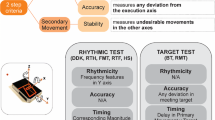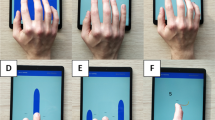Abstract
Background
The use of objective measurements is essential to assess disease progression and to evaluate the effectiveness of rehabilitation protocols and clinical treatments.
Aim
The purpose of this study was to develop a touch-screen application, that we named 15-White Dots APP-Coo-Test (15-WDACT), able to carry out quantitative and objective measurements of the rapid and coordinated upper limb movements, typically impaired in patients with cerebellar ataxias (CA).
Methods
A total of 87 CA patients and 170 healthy subjects participated in this study. The subject was asked to touch with their index finger a white dot, appearing consecutively and randomly on the screen at different positions, for a total of 15 dots per session. The score is the execution time of a single session.
Results
15-WDACT measurements have highly correlated with the scores obtained with the Scale for the Assessment and Rating of Ataxia (SARA), with the Composite Cerebellar Functional Severity (CCFS) and with the measurements obtained using two validated evaluating systems, i.e., the Nine Hole Pegboard test (9HPT) and the Click Test. We also observed high internal consistency and an excellent intra-rater and test–retest reliability. We found a small Standard Error of Measurement (SEM) and an excellent Minimal Detectable Change (MDC), indicating that even small variations in the 15-WDACT measurements are to be associated with real changes in performance.
Conclusions
We have concluded that 15-WDACT is an easy, fast and reliable tool to assess the severity of the upper limb ataxia in patients with CA.




Similar content being viewed by others
References
Bodranghien F, Bastian A, Casali C, Hallett M, Louis ED, Manto M et al (2016) Consensus paper: revisiting the symptoms and signs of cerebellar syndrome. Cerebellum 15(3):369–391
Patel M, Isaacs CJ, Seyer L, Brigatti K, Gelbard S, Strawer C et al (2016) Progression of Friedreich ataxia: quantitative characterization over 5 years. Ann Clin Transl Neurol 3:684–694
Reetz K, Dogan I, Hilgers RD, Giunti P, Mariotti C, Durr A et al (2016) Biological and clinical characteristics of the European Friedreich’s Ataxia Consortium for Translational Studies (EFACTS) cohort: a cross-sectional analysis of baseline data. Lancet Neurol 15:1346–1354
Diallo A, Jacobi H, Cook A, Labrum R, Durr A, Brice A et al (2018) Survival in patients with spinocerebellar ataxias types 1,2,3 and 6 (EUROSCA): a longitudinal cohort study. Lancet Neurol 17:327–334
Yabe I, Matsushima M (2008) Usefulness of the scale for the assessment and rating of ataxia (SARA). J Neurol Sci 266:164–166
Schmitz-Hubsch T et al (2006) Scale for the assessment of ataxia: development of a new clinical scale. Neurology 66:1717–1720
Weyer A, Abele M, Schmitz-Hubsch T (2007) Reliability and validity of the scale for the assessment and rating of ataxia: a study in 64 ataxia patients. Mov Disord 22:1633–1637
Bürk K, Sival DA (2018) Scales for clinical evaluation of cerebellar disorders. Hand Clin Neurol 154:329–339
Tanguy Melac A, Mariotti C, Filipovic Pierucci A, Giunti P, Arpa J, Boesch S et al (2018) Friedreich and dominant ataxias: quantitative differences in cerebellar dysfunction measurements. J Neurol Neurosurg Psychiatry 89:559–565
Schmitz-Hübsch T, Tezenas-Du-Montcel S, Baliko L, Boesch S, Bonato S, Fancellu R et al (2005) Reliability and validity of the international cooperative ataxia rating scale: a study in 156 spinocerebellar ataxia patients. Mov Disord 21:699–704
Tison F, Yekhlef F (2002) Application of the international cooperative ataxia scale rating in multiple system atrophy. Mov Disord 17(6):1248–1254
Schmitz-Hübsch T, Giunti P, Stephenson DA, Globas C, Baliko L, Saccà F et al (2008) SCA Functional Index—usefulness of a compound performance measure in spinocerebellar ataxia patients. Neurology 71:486–492
Schmitz-Hübsch T, Fimmers R, Rakowicz M, Rola R, Zdzienicka E, Fancellu R et al (2010) Responsiveness of different rating instruments in spinocerebellar ataxia patients. Neurology 74:678–684
du Montcel ST, Charles P, Ribai P, Goizet C, Le Bayon A, Labauge P et al (2008) Composite cerebellar functional severity score: validation of a quantitative score of cerebellar impairment. Brain 131:1352–1361
Mathiowetz V, Weber K, Kashman N, Volland G (1985) Adult norms for the nine hole peg test of finger dexterity. Occup Ther J Res 5(1):24–38
Oxford Grice K, Vogel KA, Le V, Mitchell A, Muniz S, Vollmer MA (2003) Adult norms for a commercially available nine hole peg test for finger dexterity. Am J Occup Ther 57(5):570–573
Paap BK, Roeske S, Durr A, Schöls L, Ashizawa T, Boesch S, Bunn LM et al (2016) Standardized assessment of hereditary ataxia patients in clinical studies. Mov Disord Clin Pract 3(3):230–240
Tanguy Melac A, Mariotti C, Filipovic Pierucci A, Giunti P, Arpa J, Boesch S, Klopstock T, Müller Vom Hagen J, Klockgether T, Bürk K, Schulz JB, Reetz K, Pandolfo M, Durr A, Tezenas du Montcel S (2018) Friedreich and dominant ataxias: quantitative differences in cerebellar dysfunction measurements. J Neurol Neurosurg Psychiatry 89(6):559–565
Portney LG, Watkins MP (2009) Foundations of clinical research: applications to practice. Pearson/Prentice Hall, Upper Saddle River
Baumgartner TA, Chung H (2001) Confidence limits for intraclass reliability coefficients. Meas Phys Educ Exerc Sci 5:179–188
Harvill L (1991) Standard error of measurement. Educ Meas 10:33–41
Donoghue D, Stokes EK (2009) How much change is true change? The minimum detectable change of the Berg Balance Scale in elderly people. J Rehabil Med 41:343–346
Haley SM, Fragala-Pinkham MA (2006) Interpreting change scores of tests and measures used in physical therapy. Phys Ther 86:735–743
Serrao M, Pierelli F, Ranavolo A, Draicchio F, Conte C, Casali C et al (2012) Gait pattern in inherited cerebellar ataxias. Cerebellum 11(1):194–211
Fujioka S, Sundal C, Zbigniew K (2013) Autosomal dominant cerebellar ataxia type III: a review of the phenotypic and genotypic characteristics. Orphanet J Rare Dis 18(8):14
Schols L, Bauer P, Schmidt T, Schulte T, Riess O (2004) Autosomal dominant cerebellar ataxias: clinical features, genetics, and pathogenesis. Lancet Neurol 3:291–304
Basri R, Yabe I, Soma H, Sasaki H (2007) Spectrum and prevalence of autosomal dominant spinocerebellar ataxia in Hokkaido, the northern island of Japan: a study of 113 Japanese families. J Hum Genet 52:848–855
Author information
Authors and Affiliations
Corresponding author
Ethics declarations
Conflicts of interest
The manuscript has been approved by all the authors. The authors declare that they have no financial kind of relationships that might lead to a conflict of interest.
Ethical approval
This study was conducted in the Department of Medical and Surgical Sciences and Biotechnologies, “Sapienza” University of Rome, at “Marco Pasquali” Institute—ICOT (Latina), from October 2016 to September 2018. All patients who participated to the study were informed of the use of measurements for research purposes and gave their written informed consent. All the procedures performed were in accordance with the ethical standards of the institutional and national research committee. The regulations of our institution concerning intellectual property has been respected. The ethical standards, laid down in 1964 Declaration of Helsinki and its later amendments, were respected.
Electronic supplementary material
Below is the link to the electronic supplementary material.
415_2019_9299_MOESM2_ESM.pdf
Supplementary material 2 Four different examples of reports generated by the APP-Coo-Test. a refers to a healthy subject, while b, c and d refer to three patients with different ataxia levels as reported by a SARA score of 10, 20 and 30, respectively (PDF 107 kb)
415_2019_9299_MOESM3_ESM.pdf
Supplementary material 3 Some phases of the 15-WDACT: The patient selects the 15-WDACT on the screen (a), then presses the start button (b); the countdown that prepares the patient to perform the test starts (c, d, e); the first dot appears on the screen and the test begins (f); the patient types with their index finger on the 15 white dots that will appear on the screen sequentially in random positions (g–i, l–v); after reaching all the 15th white dots the test stops and the execution time appears on the screen (z) (PDF 307 kb)
Rights and permissions
About this article
Cite this article
Arcuria, G., Marcotulli, C., Galasso, C. et al. 15-White Dots APP-Coo-Test: a reliable touch-screen application for assessing upper limb movement impairment in patients with cerebellar ataxias. J Neurol 266, 1611–1622 (2019). https://doi.org/10.1007/s00415-019-09299-9
Received:
Revised:
Accepted:
Published:
Issue Date:
DOI: https://doi.org/10.1007/s00415-019-09299-9




